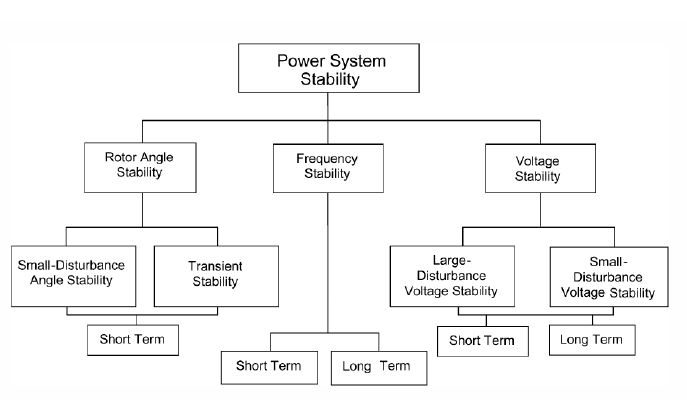Home » Posts tagged 'voltage stability'
Tag Archives: voltage stability
Power System Stability & its Types
At present the demand for electricity is rising phenomenally especially in developing country like India. This persistent demand is leading to operation of the power system at its limit. On top of this the need for reliable, stable and quality power is also on the rise due to electric power sensitive industries like information technology, communication, electronics etc. In this scenario, meeting the electric power demand is not the only criteria but also it is the responsibility of the power system engineers to provide a stable and quality power to the consumers. These issues highlight the necessity of understanding the power system stability. In this course we will try to understand how to asses the stability of a power system, how to improve the stability and finally how to prevent system becoming unstable.
Power system stability is the ability of an electric power system, for a given initial operating condition, to regain a state of operating equilibrium after being subjected to a physical disturbance, with most of the system variables bounded so that practically the entire system remains intact . The disturbances mentioned in the definition could be faults, load changes, generator outages, line outages, voltage collapse or some combination of these. Power system stability can be broadly classified into rotor angle, voltage and frequency stability. Each of these three stabilities can be further classified into large disturbance or small disturbance, short term or long term. The classification is depicted in Fig.
1.Rotor Angle Stability:
It is the ability of the system to remain in synchronism when subjected to a disturbance. The rotor angle of a generator depends on the balance between the electromagnetic torque due to the generator electrical power output and mechanical torque due to the input mechanical power through a prime mover. Remaining in synchronism means that all the generators electromagnetic torque is exactly balanced by the mechanical torque. If in some generator the balance between electromagnetic and mechanical torque is disturbed, due to disturbances in the system, then this will lead to oscillations in the rotor angle. Rotor angle stability is further classified into small disturbance angle stability and large disturbance angle stability.
A. Small-disturbance or small-signal angle stability
It is the ability of the system to remain in synchronism when subjected to small disturbances. If a disturbance is small enough so that the nonlinear power system can be approximated as a linear system, then the study of rotor angle stability of that particular system is called as small-disturbance angle stability analysis. Small disturbances can be small load changes like switching on or off of small loads, line tripping, small generators tripping etc. Due to small disturbances there can be two types of instability: non-oscillatory instability and oscillatory instability. In non-oscillatory instability the rotor angle of a generator keeps on increasing due to a small disturbance and in case of oscillatory instability the rotor angle oscillates with increasing magnitude.
B.Large-disturbance or transient angle stability
It is the ability of the system to remain in synchronism when subjected to large disturbances. Large disturbances can be faults, switching on or off of large loads, large generators tripping etc. When a power system is subjected to large disturbances they will lead to large excursions of generator rotor angles. Since there are large rotor angle changes the power system cannot be approximated by a linear representation like in the case of small-disturbance stability. The time domain of interest in case of large-disturbance as well as small-disturbance angle stability is any where between 0.1- 10 s. Due to this reason small and large-disturbance angle stability are considered to be short term phenomenon.
2.Voltage stability
It is the ability of the system to maintain steady state voltages at all the system buses when subjected to a disturbance. If the disturbance is large then it is called as large-disturbance voltage stability and if the disturbance is small it is called as small-disturbance voltage stability. Unlike angle stability, voltage stability can also be a long term phenomenon. In case voltage fluctuations occur due to fast acting devices like induction motors, power electronic drive, HVDC etc then the time frame for understanding the stability is in the range of 10-20 s and hence can be treated as short term phenomenon. On the other hand if voltage variations are due to slow change in load, over loading of lines, generators hitting reactive power limits, tap changing transformers etc then time frame for voltage stability can stretch from 1 minute to several minutes.
The main difference between voltage stability and angle stability is that voltage stability depends on the balance of reactive power demand and generation in the system where as the angle stability mainly depends on the balance between real power generation and demand.
3.Frequency stability
It refers to the ability of a power system to maintain steady frequency following a severe disturbance between generation and load. It depends on the ability to restore equilibrium between system generation and load, with minimum loss of load. Frequency instability may lead to sustained frequency swings leading to tripping of generating units or loads. During frequency excursions, the characteristic times of the processes and devices that are activated will range from fraction of seconds like under frequency control to several minutes, corresponding to the response of devices such as prime mover and hence frequency stability may be a short-term phenomenon or a long-term phenomenon.

